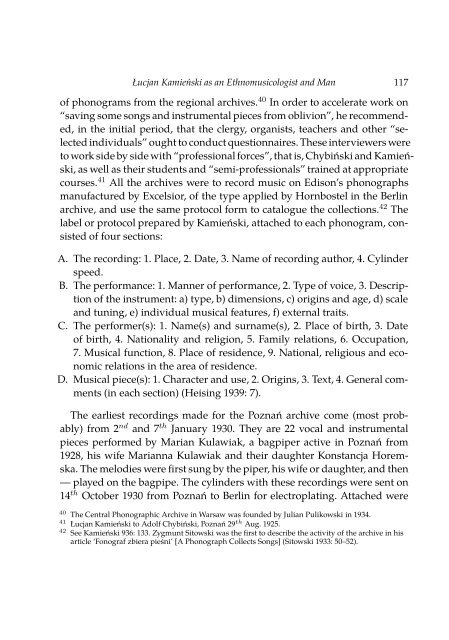Musicology Today 2012 100 Years of Polish Musicology
Musicology Today 2012 100 Years of Polish Musicology
Musicology Today 2012 100 Years of Polish Musicology
Create successful ePaper yourself
Turn your PDF publications into a flip-book with our unique Google optimized e-Paper software.
Łucjan Kamieński as an Ethnomusicologist and Man 117<br />
<strong>of</strong> phonograms from the regional archives. 40 In order to accelerate work on<br />
“saving some songs and instrumental pieces from oblivion”, he recommended,<br />
in the initial period, that the clergy, organists, teachers and other “selected<br />
individuals” ought to conduct questionnaires. These interviewers were<br />
to work side by side with “pr<strong>of</strong>essional forces”, that is, Chybiński and Kamieński,<br />
as well as their students and “semi-pr<strong>of</strong>essionals” trained at appropriate<br />
courses. 41 All the archives were to record music on Edison’s phonographs<br />
manufactured by Excelsior, <strong>of</strong> the type applied by Hornbostel in the Berlin<br />
archive, and use the same protocol form to catalogue the collections. 42 The<br />
label or protocol prepared by Kamieński, attached to each phonogram, consisted<br />
<strong>of</strong> four sections:<br />
A. The recording: 1. Place, 2. Date, 3. Name <strong>of</strong> recording author, 4. Cylinder<br />
speed.<br />
B. The performance: 1. Manner <strong>of</strong> performance, 2. Type <strong>of</strong> voice, 3. Description<br />
<strong>of</strong> the instrument: a) type, b) dimensions, c) origins and age, d) scale<br />
and tuning, e) individual musical features, f) external traits.<br />
C. The performer(s): 1. Name(s) and surname(s), 2. Place <strong>of</strong> birth, 3. Date<br />
<strong>of</strong> birth, 4. Nationality and religion, 5. Family relations, 6. Occupation,<br />
7. Musical function, 8. Place <strong>of</strong> residence, 9. National, religious and economic<br />
relations in the area <strong>of</strong> residence.<br />
D. Musical piece(s): 1. Character and use, 2. Origins, 3. Text, 4. General comments<br />
(in each section) (Heising 1939: 7).<br />
The earliest recordings made for the Poznań archive come (most probably)<br />
from 2 nd and 7 th January 1930. They are 22 vocal and instrumental<br />
pieces performed by Marian Kulawiak, a bagpiper active in Poznań from<br />
1928, his wife Marianna Kulawiak and their daughter Konstancja Horemska.<br />
The melodies were first sung by the piper, his wife or daughter, and then<br />
— played on the bagpipe. The cylinders with these recordings were sent on<br />
14 th October 1930 from Poznań to Berlin for electroplating. Attached were<br />
40 The Central Phonographic Archive in Warsaw was founded by Julian Pulikowski in 1934.<br />
41 Łucjan Kamieński to Adolf Chybiński, Poznań 29 th Aug. 1925.<br />
42 See Kamieński 936: 133. Zygmunt Sitowski was the first to describe the activity <strong>of</strong> the archive in his<br />
article ‘Fonograf zbiera pieśni’ [A Phonograph Collects Songs] (Sitowski 1933: 50–52).
















